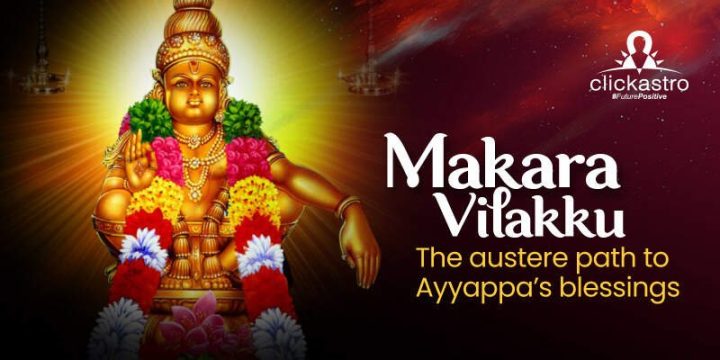Makara Vilakku is a Kerala religious festival held every year at the famous
Sabarimala Temple. Makaravilakku is celebrated on the first day of Makara month or masam as it is known in the Malayalam calendar corresponding to January as per the Gregorian Calendar. Makaravilakku is on the same day as
Makara Sankranti which is celebrated across other parts of India. On this auspicious day, devotees from all over India flock to Sabarimala’s revered Ayyappa temple for Makara Vilakku darshan and to see the Makara Jyothi.
Makara (the zodiac sign of Capricorn) and Vilakku (light) together make up the name Makaravilakku. The most significant activity during the Makaravilakku festival is viewing the Makara Vilakku and Makara Jyothi. The devotees gathered at the sanctum sanctorum, also known as Sannidhanam, eagerly anticipate the procession that brings the divine gold ornaments of Lord Ayyappa, known as “Thiruvabharanam,” from
Pandalam Palace to the temple at Sabarimala.

It is believed that Lord Ayyappa, also known as Ayyappa Swami, is the son of Lord Shiva and Mohini, the sole female manifestation of Lord Vishnu. In India, Ayyappa Swami is revered and worshipped by his followers. The pilgrimage destination is his temple in Sabarimala. Devotees begin preparations for the Makaravilakku on the first of the Vrischikam month (mid-November to mid-December) according to the Malayalam calendar, which is two months in advance.
It is mandatory to observe a fast for 41 days before attending the Makara Vilakku festival or Mandala puja at the Ayyappa temple in Sabarimala. The Mandala puja is considered be extremely virtuous, and it concludes on Makaravilakku day at the Ayyappa temple in Sabarimala. It is believed to change lives and grant the wishes of the devotees. Sannidhanam, Paanithavalam, Saramkuthi, Marakootam, Pulmedu, Hilltop, Neelimala, Chalakayam, and Attathodu are the nine locations where devotees can sight the Makaravilakku.
When is Makara Vilakku in 2023
In 2024, Makaravilakku will be celebrated on Monday, 15th January.
The important timings are as follows:
Makaravilakku Timing: 6.30 pm – 7.00 pm on January 15.
Makara Vilakku Fasting Vidhi and Rituals
Before visiting the Sabarimala Ayyappa Temple for the Makaravilakku festival, devotees are required to adhere strictly to the Makaravilakku Vidhi, also known as
Mandalakaalam. Every devotee who wishes to make the pilgrimage to the Sabarimala temple must participate in the Mandalakaalam, which begins on the first day of the Malayalam month of Vrischikam. Only women over the age of 50 and girls between the ages of 1 and 9 are permitted to enter the revered Ayyappa temple in Sabarimala.
Ayyappa devotees must observe an austere life for 41 days and observe the Makaravilakku vrat. The Makara Vilakku vrat vidhi entails fasting throughout the day and consuming a simple vegetarian meal only once per day. The Makaravilakku fast’s primary goal is to purify the body, mind, and soul.
Devotees who visit the Sabarimala Ayyappa Temple for Makaravilakku wear a necklace made of
Rudraksha and Tulsi beads and a locket of Lord Ayyappa, which is only taken off after the Makaravilakku puja and after seeing the holy light on that day.
Alcohol, smoking, gambling, and other vices are not allowed during these 41 days.
As Lord Ayyappa is reputed to be a Brahmachari, devotees should observe celibacy for 41 days.
The devotees should avoid all luxuries and worldly pleasures during this time. They are required to walk barefoot, sleep on the floor, and only spend time in prayer and meditation. Those who work full-time and are time-constrained must at least pray twice daily.
Men are not permitted to trim or shave their hair, beards, or mustaches.
The devotees observing Makaravilakku vrat must dress in black, deep blue, or saffron attire up until the final day of Makara Vilakku celebrations at Lord Ayyappa’s divine Sannidhanam.
The pilgrim also carries a cloth bundle on their heads called “irumudi” which is divided into two parts. This bundle consists of rice, coconut, ghee, and camphor which is offered to Lord Ayyappa during their visit to the shrine on Makaravilakku. The ritual of filling this cloth bundle is known as Kettunira.
Before reaching the Ayyappa Temple at Sabarimala, the devotees visit the Ganapathi temple at Pampa where they offer prayers and worship Lord Ganapathi. From Pampa, they undertake an arduous trek through dense forest and rough terrains climbing the hill to the Sannidhanam. No vehicles are permitted beyond Pampa.
Following the Makara Vilakku darshan and Puja, the devotees conclude the rituals by visiting the
Krishna Temple at Guruvayur.
The 41-day fasting and austerities come to an end on Makaravilakku day. Some of the devotees stay in Sabarimala and return only after the Kuruthi Puja which concludes the seven-day festival.
Significance Of Makara Vilakku
The Sabarimala Ayyappa Temple in Kerala has been hosting Makaravilakku celebrations ever since it was first established. People from other states join in on this annual celebration in addition to those from Kerala and other southern Indian states. Observing the Makara Jyothi and the Makaravilakku in the evening is one of the main significances of the Makaravilakku.
The Makarajyothi, a prominent Sirius star rising that evening over Ponnambalamedu in Sabarimala’s eastern sky, is visible from the temple. The sacred light known as Makaravilakku can be seen three times from Sabarimala while it happens in the Ponnambalamedu forest, which is near Sabarimala in the western ghats. On that day, devotees begin walking from Pampa to the Sabarimala temple in the morning and keep the Makaravilakku fast all day.
Lord Ayyappa’s gold ornaments, known as the Thiruvabharanam, are ceremoniously transported in a procession from the Pandalam palace to the Sabarimala Ayyappa temple. Lord Ayyappa’s ornaments are kept safe by the former Royal family of Pandalam. According to observations made over the years, an eagle is said to soar above the Thiruvabharanam as it travels from Pandalam Palace to the Sabarimala Ayyappa Temple. Once there, the eagle performs nine circles of the Sannidhanam, or sanctum sanctorum, revering Lord Ayyappa. The eagle is considered to be Garuda, Lord Vishnu’s vehicle or vahana.
The Thiruvabharanam procession which commenced from Pandalam Palace arrives in the evening of Makaravilakku, in which the ornaments are carried by designated men. Lord Ayyappa is then adorned with the holy ornaments, and then the Deeparadhana is performed for the divine deity. The most significant puja on the Sabarimala Makaravilakku day is the evening Deeparadhana.
At the exact moment of Deeparadhana, the Makara Jyothi is also sighted and marks the beginning of the seven-day Makaravilakku festival celebration. The fervent crowd of worshippers fills the air with their chants of “Swamiye Saranam Ayyappa.” The worshippers then get to view the sacred light known as Makaravilakku from Ponnambalamedu.
According to legend, the light coming from the Ponnambalamedu plateau temple is what’s seen in Makaravilakku. At one time, the Malay Araya tribe performed a ritual at the Ponnambalamedu temple. However, now the
Travancore Devaswom Board is in charge and continues to carry out the traditional religious rites. According to the regulations of Kerala’s Forest Department, the general public is not permitted access to the Ponnambalamedu forest.
After seeing the Makara star or Makara Jyoti, a ritualistic Aarti is performed at the Ponnambalamedu temple, and the Makaravilakku is the brightness generated from the camphor lit during the Aarti, seen thrice from Sabarimala. The sacred light, also known as Makaravilakku, is thought to be celestial by the devotees. With the sighting of Makara Vilakku, the followers’ fervor reaches a new high, and the festival’s spiritual goal is attained. For the followers, it is a confirmation of Lord Ayyappa’s omnipresence and blessings.
The devotees are distributed prasadam of Aravana payasam and appam to consume and take home.
Another significance of Makaravilakku is that it coincides with Makar Sankranti, an auspicious day when the Sun transits moves towards the north and transits from Sagittarius (Dhanu) to Makar (Capricorn). On this day, the Sun God is worshipped and thanked for his steadfast blessings of bountiful harvest.
The Legend of Sabarimala Ayyappa
King Rajashekara, a member of the Pandya dynasty who ruled over Pandalam in the state of Travancore, was the foster father of Ayyappa. King Rajashekara reigned over a golden age and was adored by his people. The king, however, had no offspring and therefore prayed to Shiva for a child along with his queen.
Meanwhile, a demon by the name of Mahishasura underwent painful penance and obtained a blessing from Lord Brahma that no one on earth could harm him. With this boon, Mahishasura began to hassle and hurt innocent people. People fled from their homes out of fear of him. He was finally defeated by Goddess Durga in a conflict.
Mahishasura’s sister, Mahishi, decided to seek revenge for her brother. She underwent penance and received a blessing from Lord Brahma that only a child of Hari (Vishnu) and Haran (Shiva) could destroy her. With this boon, she started to harass the gods who begged Lord Vishnu to step in. Lord Vishnu then assumed the form of Mohini, giving birth to a son through the union of Mohini and Shiva.
The child borne out of this union was then sent to the earth. King Rajashekara during one of his hunting sessions, discovered the child while hunting in the woods close to the Pampa River. A holy man instructed him to take the child to his palace. He added that the child would put an end to his dynasty’s problems and that the king would recognize his divinity when the boy turned 12 years old. The holy man advised the king to give the child the name Manikandan, which means “one with a golden neck,” as the child had a gold chain around his neck.
The boy was raised in the palace by King Rajasekhara, who took the infant home. Manikandan was a compassionate, bright, and quick-witted child. Meanwhile, the queen gave birth to a son named Raja Rajan. Manikandan was chosen by King Rajasekhara to be his heir apparent because he believed he was responsible for the miracles and also because he was his eldest son. However, the Diwan, who had a secret ambition to rule, turned the queen against Manikandan.
The Diwan made the queen feign illness and with the collusion of the court physician declared that only the milk of a tigress could heal the queen from her illness. Manikandan set out to bring the tigress’ milk from the forest. He witnessed Mahishi’s atrocities while wandering the forest. After a struggle, he killed her.
Following his battle with Mahishi, Lord Shiva appeared before Manikandan and divulged the reason for his birth, and promised him that Lord Indra would assist him in obtaining the tigress’ milk. Manikandan arrived back at the palace while perched atop Lord Indra, who had assumed the form of a tiger. The Gods and Goddesses assumed the form of tigers and tigresses and followed after him.
The holy man then reappeared and revealed to the king who Manikandan was. The king apologized for his wife’s actions. The day he returned from the forest, Manikandan turned twelve years old.
When King Rajasekhara decided to punish the Diwan, Manikandan advised King Rajasekhara not to as everything that had occurred was God’s will. He also informed his father that once his duty was complete, he would go back to Devaloka. As King Rajasekhara was reluctant to let him go, Manikandan granted him to construct a temple in his honor. Manikandan shot an arrow, which landed at a location known as Sabari. He instructed the King to construct the temple there before leaving.
The foundation stone for the Sabarimala temple was laid by the king following the advice of Sage Agastya. Manikandan declared that only devotees who adhered to strict penance and abstinence for 41 days would receive His blessing.
Legend has it that Lord Ayyappa or Dharmashastha as he is also known sent Parasuraman, the creator of Kerala, to Sabarimala to carve and install the idol of Lord Ayyappa on Makara Sankranti day.
Each year, millions of devotees visit the temple with irumudis and garlands while singing hymns to Lord Ayyappa. They take a dip in the revered Pampa River and ascend the 18 steps known as Pathinettam Padi to see the Lord.
The temple is situated atop one of the Western Ghats’ rough hills. Most devotees undertake the main pilgrimage between November and January. Before undertaking the pilgrimage, devotees practice strict penance. The shrine is frequented by people of all races and religions. The shrine is only open to women who are past menopause or young girls who have not reached puberty.

 It is believed that Lord Ayyappa, also known as Ayyappa Swami, is the son of Lord Shiva and Mohini, the sole female manifestation of Lord Vishnu. In India, Ayyappa Swami is revered and worshipped by his followers. The pilgrimage destination is his temple in Sabarimala. Devotees begin preparations for the Makaravilakku on the first of the Vrischikam month (mid-November to mid-December) according to the Malayalam calendar, which is two months in advance.
It is mandatory to observe a fast for 41 days before attending the Makara Vilakku festival or Mandala puja at the Ayyappa temple in Sabarimala. The Mandala puja is considered be extremely virtuous, and it concludes on Makaravilakku day at the Ayyappa temple in Sabarimala. It is believed to change lives and grant the wishes of the devotees. Sannidhanam, Paanithavalam, Saramkuthi, Marakootam, Pulmedu, Hilltop, Neelimala, Chalakayam, and Attathodu are the nine locations where devotees can sight the Makaravilakku.
It is believed that Lord Ayyappa, also known as Ayyappa Swami, is the son of Lord Shiva and Mohini, the sole female manifestation of Lord Vishnu. In India, Ayyappa Swami is revered and worshipped by his followers. The pilgrimage destination is his temple in Sabarimala. Devotees begin preparations for the Makaravilakku on the first of the Vrischikam month (mid-November to mid-December) according to the Malayalam calendar, which is two months in advance.
It is mandatory to observe a fast for 41 days before attending the Makara Vilakku festival or Mandala puja at the Ayyappa temple in Sabarimala. The Mandala puja is considered be extremely virtuous, and it concludes on Makaravilakku day at the Ayyappa temple in Sabarimala. It is believed to change lives and grant the wishes of the devotees. Sannidhanam, Paanithavalam, Saramkuthi, Marakootam, Pulmedu, Hilltop, Neelimala, Chalakayam, and Attathodu are the nine locations where devotees can sight the Makaravilakku.







